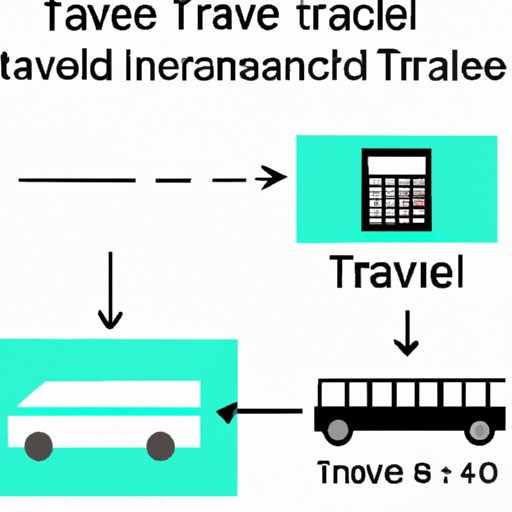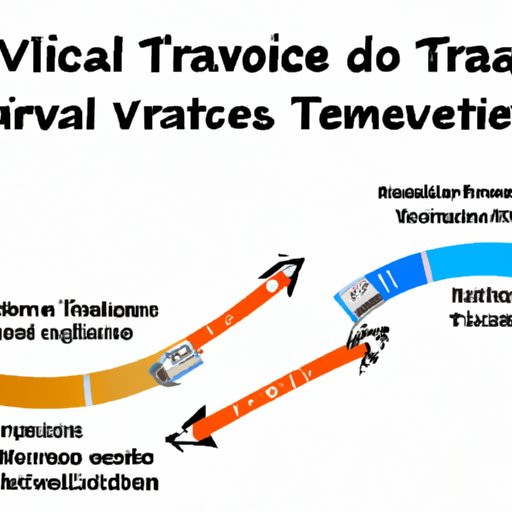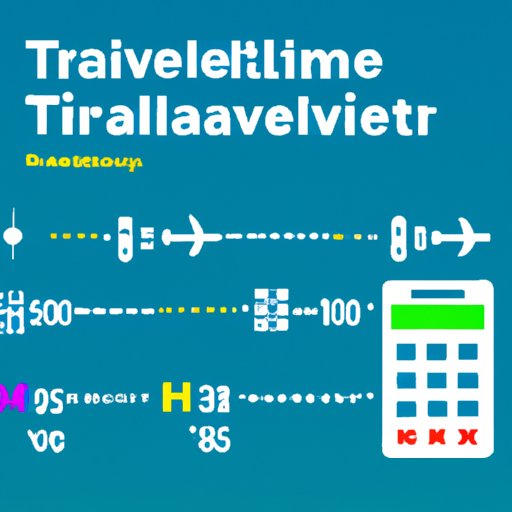Introduction
The travel time formula is used to calculate the amount of time it takes to travel from one location to another. This formula is often used by travelers, transportation companies, and logistics professionals when planning trips or routes. This article will provide an overview of the travel time formula, explain how to calculate travel time, and examine the factors that can affect the calculation.
Explaining the Travel Time Formula Step-by-Step
To calculate travel time, you must first determine the distance, speed, and time for the route. Distance is simply the total length of the journey, while speed is the average speed at which the journey will be completed. Finally, time is the total amount of time it will take to complete the journey. Once these three variables have been determined, you can use the following equation to calculate travel time:
Travel Time = Distance / Speed
For example, if you are travelling 100 miles at a speed of 50 miles per hour, the travel time would be calculated as follows:
Travel Time = 100 miles / 50 miles per hour = 2 hours

Using Examples to Illustrate How to Calculate Travel Time
To further illustrate how to calculate travel time, let’s look at two examples. In the first example, a person is travelling from Los Angeles to San Francisco, a distance of about 400 miles. The person plans to drive at an average speed of 70 miles per hour. To calculate the travel time, we plug the values into the equation:
Travel Time = 400 miles / 70 miles per hour = 5.71 hours
In the second example, a person is travelling from London to Paris, a distance of about 350 miles. The person plans to fly at an average speed of 500 miles per hour. To calculate the travel time, we plug the values into the equation:
Travel Time = 350 miles / 500 miles per hour = 0.7 hours (or 42 minutes)
Breaking Down the Components of the Travel Time Formula
Now that we’ve seen how to calculate travel time with the formula, let’s take a closer look at each component of the equation.
Distance
Distance is the total length of the journey in miles or kilometers. It’s important to note that some routes may be longer than others due to detours or traffic. Therefore, it’s best to estimate the distance before calculating travel time.
Speed
Speed is the average speed at which the journey will be completed, usually measured in miles or kilometers per hour. It’s important to consider the speed limits on the roads or airways you’ll be travelling on, as well as any potential delays such as traffic or weather.
Time
Time is the total amount of time it will take to complete the journey. This can be measured in hours, minutes, or seconds depending on the level of precision you need.
Comparing Different Travel Time Formulas
The travel time formula can be used to calculate the time it takes to travel by car, plane, or even on foot. Each mode of transportation has its own unique formula for calculating travel time.
Driving Time
When travelling by car, the travel time formula is typically used. This formula takes into account the distance, speed, and time needed to complete the journey.
Flying Time
When travelling by plane, the flight time formula is often used. This formula takes into account the distance between two airports, the average speed of the aircraft, and the total time needed to complete the journey.
Walking Time
When travelling by foot, the walking time formula is often used. This formula takes into account the distance, average walking speed, and total time needed to complete the journey.

Examining Variables That Affect Travel Time
In addition to the variables used in the travel time formula, there are also other external factors that can affect the calculation. For example, weather conditions and traffic congestion can both impact the amount of time it takes to complete a journey.
Weather Conditions
Weather conditions can have a significant impact on travel time. For example, inclement weather such as rain or snow can slow down a vehicle’s speed, resulting in increased travel time.
Traffic Congestion
Traffic congestion can also affect travel time. During peak hours, roads may be more congested, resulting in slower speeds and increased travel time.

Creating a Travel Time Calculator Tool
A travel time calculator is a useful tool for travelers, transportation companies, and logistics professionals. This tool can be used to quickly calculate travel time based on distance, speed, and time. Here are some benefits of using a travel time calculator:
- Save time: Calculating travel time manually can be time-consuming. With a travel time calculator, you can quickly and accurately calculate travel time.
- Reduce errors: Manually calculating travel time can lead to errors. With a travel time calculator, you can reduce the risk of making mistakes.
- Increase efficiency: A travel time calculator can help you plan your trips more efficiently.
If you’re interested in creating a travel time calculator, here are some guidelines to follow:
- Determine the type of calculator you want to create. Do you want to create a calculator for cars, planes, or walking?
- Gather the necessary data. You will need to collect data on distances, speeds, and times for the calculator.
- Design the user interface. This should be easy to use and understand.
- Test the calculator. Test the calculator to ensure it works correctly.
- Launch the calculator. Once the calculator is tested, you can launch it for public use.
Conclusion
The travel time formula is a useful tool for calculating the amount of time it takes to travel from one location to another. By understanding the components of the formula and the factors that can affect the calculation, you can calculate travel time more accurately. Additionally, you can create a travel time calculator tool to save time and increase efficiency.
(Note: Is this article not meeting your expectations? Do you have knowledge or insights to share? Unlock new opportunities and expand your reach by joining our authors team. Click Registration to join us and share your expertise with our readers.)
